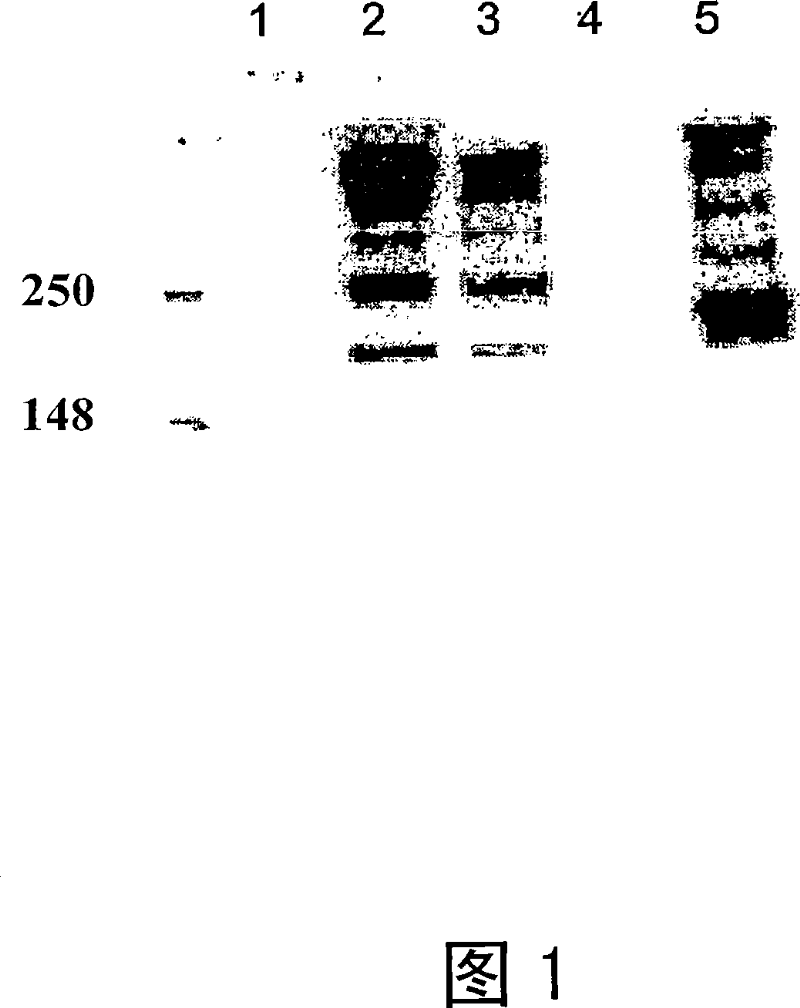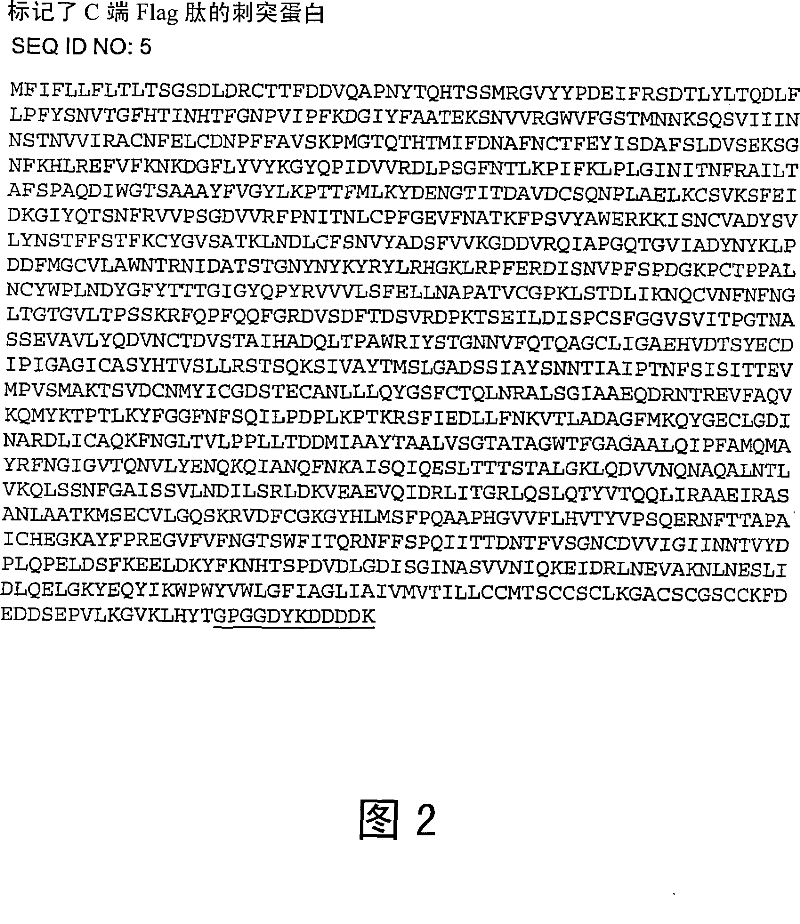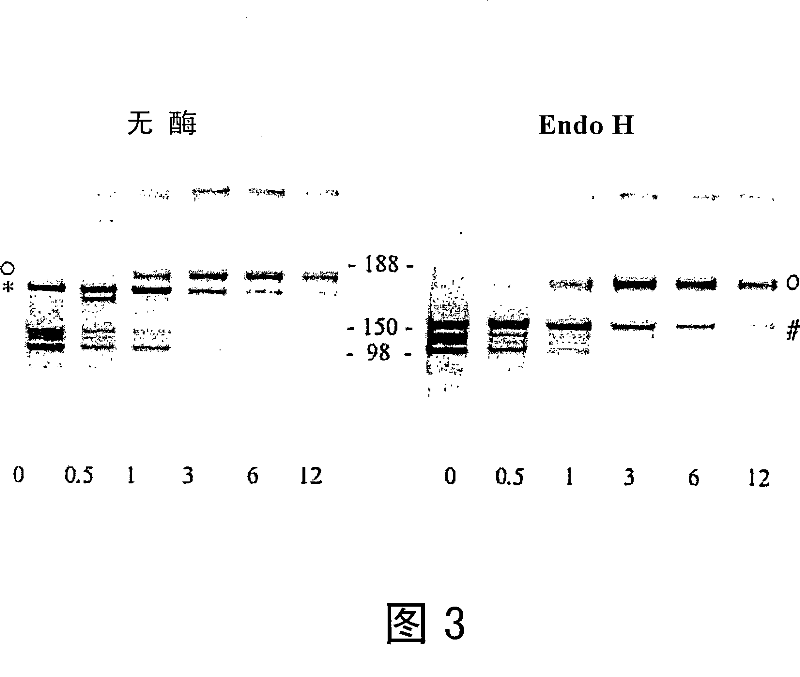Nucleic acids, polypeptides, methods of expression, and immunogenic compositions associated with sars corona virus spike protein
A technology of spike polypeptide and spike protein, which is applied in the directions of antiviral immunoglobulin, chemical instruments and methods, biochemical equipment and methods, etc., can solve the problems of not giving results and so on
- Summary
- Abstract
- Description
- Claims
- Application Information
AI Technical Summary
Problems solved by technology
Method used
Image
Examples
Embodiment 1
[0111] A spike gene (Spike gene) from a patient infected with SARS CoV was obtained, called Spike-Pasteur (SEQ ID NO: 1). The Spike-Pasteur was cloned into pcDNA eukaryotic expression vector and transfected into 293T cells. Cells transfected with pcDNA-Spike-Pasteur did not express the Spike-Pasteur polypeptide, as no detectable levels of the Spike protein were observed by either FACS or Western blotting.
[0112] Spike-Pasteur was then expressed in a SFV viral expression vector capable of efficient expression in transfected BHK cells. However, the yield of SFV virions was low due to the presence of 2 Spe I sites in the spike gene. Spe I is commonly used to linearize the plasmid at the end of the SFV coding sequence. Since Spe I could not be used, PSFV-Spike-Pasteur was linearized using Sph I, which generated an additional 3' RNA sequence of >2000 bases of the carrier RNA. Representative expression levels from cells infected with SFV-Spike-Pasteur were weak.
[0113] To en...
Embodiment 2
[0115] Further bioinformatics analysis was performed on the Spike-Pasteur sequence. The cDNA for Spike-Pasteur contains many cis-acting sites that can negatively affect expression. To further enhance expression, 32 of the 33 negative cis-acting signals identified were eliminated from Spike-Pasteur and an additional signal that stimulated gene expression was added, resulting in Spike-HKU-PRC (SEQ ID NO: 3). Spike-HKU-PRC was cloned into pSC, pcDNA, and pSFV vectors.
[0116] As shown in Table 1, all 19 AU-rich RNA instability motifs of Spike-Pasteur were eliminated to generate Spike-HKU-PRC. In addition, 11 of 12 putative splice donor and acceptor sites, as well as internal poly(A) and repeat and secondary sequence stretches, were removed.
[0117] Spike-Pasteur
Spike-HKU-PRC
AU-rich RNA instability motif
19
0
Repeats and secondary sequence segments
1
0
splice donor and acceptor sites
12
1
interna...
Embodiment 3
[0123]The Spike protein expression of pcDNA-Spike-Pasteur and pcDNA-Spike-HKU-PRC was compared by transfecting the plasmid into 293T cells using the calcium phosphate method. Spike protein was not observed in cells transfected with pcDNA-Spike-Pasteur. In contrast, high levels of Spike protein were detected in 293T cells transfected with pcDNA-Spike-HKU-PRC (Fig. 1). The migration and oligomerization patterns of the spike protein were consistent with previous results, suggesting that this plasmid can express the full-length, native conformation of the SARS CoV protein. These results demonstrate that codon optimization of the Spike coding sequence resulted in dramatic improvements in expression outcomes.
PUM
 Login to View More
Login to View More Abstract
Description
Claims
Application Information
 Login to View More
Login to View More - R&D
- Intellectual Property
- Life Sciences
- Materials
- Tech Scout
- Unparalleled Data Quality
- Higher Quality Content
- 60% Fewer Hallucinations
Browse by: Latest US Patents, China's latest patents, Technical Efficacy Thesaurus, Application Domain, Technology Topic, Popular Technical Reports.
© 2025 PatSnap. All rights reserved.Legal|Privacy policy|Modern Slavery Act Transparency Statement|Sitemap|About US| Contact US: help@patsnap.com



